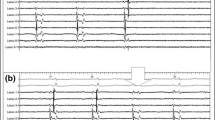Abstract
Purpose
When atrial fibrillation (AF) is initiated by a single or several non-pulmonary vein (PV) trigger ectopic beats, mapping the ectopy is often difficult, requiring a number of electrical cardioversion applications. Nifekalant is a rapidly activating delayed rectifier potassium channel (IKr) blocker which may suppress AF initiation without inhibiting ectopy development, thereby allowing the target ectopy to be mapped. To assess the efficacy of nifekalant in the ablation of non-PV ectopies that are unmappable due to easily initiated AF.
Methods
Eleven consecutive patients were administered nifekalant to map a non-PV ectopy that was unmappable using a conventional method due to easily initiated AF. Nifekalant was intravenously administered as a bolus dose of 0.2 mg/kg, and electrical cardioversion was delivered. Additional boluses of 0.2 mg/kg were repeatedly administered until AF initiation was prevented or until the appearance of significant prolongation of QT interval.
Results
AF suppression without inhibition of ectopy development was achieved in 7 patients. These patients had a higher rate of acute elimination of the ectopy than the remaining 4 patients without AF suppression (7 [100%] vs. 1 [25%] patients, p = 0.024). In addition, patients with suppression of AF initiation had a higher AF recurrence-free rate than those without (7 [100%] vs. 1 [25%] patients, p = 0.024).
Conclusion
Nifekalant administration appears useful in the ablation of non-PV ectopies that easily initiate AF.



Similar content being viewed by others
References
Chen SA, Tai CT. Catheter ablation of atrial fibrillation originating from the non-pulmonary vein foci. J Cardiovasc Electrophysiol 2005;16:229–232.
Santangeli P, Zado ES, Hutchinson MD, Riley MP, Lin D, Frankel DS, et al. Prevalence and distribution of focal triggers in persistent and long-standing persistent atrial fibrillation. Heart Rhythm. 2016;13:374–82.
Lin WS, Tai CT, Hsieh MH, Tsai CF, Lin YK, Tsao HM, et al. Catheter ablation of paroxysmal atrial fibrillation initiated by nonpulmonary vein ectopy. Circulation. 2003;107:3176–83.
Calkins H, Hindricks G, Cappato R, Kim YH, Saad EB, Aguinaga L, Akar JG, Badhwar V, Brugada J, Camm J, Chen PS, Chen SA, Chung MK, Cosedis Nielsen J, Curtis AB, Davies DW, Day JD, d'Avila A, Natasja de Groot NMS, Di Biase L, Duytschaever M, Edgerton JR, Ellenbogen KA, Ellinor PT, Ernst S, Fenelon G, Gerstenfeld EP, Haines DE, Haissaguerre M, Helm RH, Hylek E, Jackman WM, Jalife J, Kalman JM, Kautzner J, Kottkamp H, Kuck KH, Kumagai K, Lee R, Lewalter T, Lindsay BD, Macle L, Mansour M, Marchlinski FE, Michaud GF, Nakagawa H, Natale A, Nattel S, Okumura K, Packer D, Pokushalov E, Reynolds MR, Sanders P, Scanavacca M, Schilling R, Tondo C, Tsao HM, Verma A, Wilber DJ, Yamane T. 2017 HRS/EHRA/ECAS/APHRS/SOLAECE expert consensus statement on catheter and surgical ablation of atrial fibrillation. Europace 2018;20:e1-e160.
Inoue K, Kurotobi T, Kimura R, Toyoshima Y, Itoh N, Masuda M, et al. Trigger-based mechanism of the persistence of atrial fibrillation and its impact on the efficacy of catheter ablation. Circ Arrhythm Electrophysiol. 2012;5:295–301.
Lee KN, Roh SY, Baek YS, Park HS, Ahn J, Kim DH, et al. Long-term clinical comparison of procedural end points after pulmonary vein isolation in paroxysmal atrial fibrillation: elimination of nonpulmonary vein triggers versus noninducibility. Circ Arrhythm Electrophysiol. 2018;11:e005019.
Kamiya J, Ishii M, Katakami T. Antiarrhythmic effects of MS-551, a new class III antiarrhythmic agent, on canine models of ventricular arrhythmia. Jpn J Pharmacol. 1992;58:107–15.
Friedrichs GS, Chi L, Gralinski MR, Black SC, Basler GC, Mu DX, et al. MS-551 protects against ventricular fibrillation in a chronic canine model of sudden cardiac death. J Cardiovasc Pharmacol. 1995;25:314–23.
Aoki H, Suzuki T, Matsui H, Yasukochi S, Saiki H, Senzaki H, et al. Efficacy of a pure Ikr blockade with nifekalant in refractory neonatal congenital junctional ectopic tachycardia and careful attention to damaging the atrioventricular conduction during the radiofrequency catheter ablation in infancy. HeartRhythm Case Rep. 2017;3:298–301.
Author information
Authors and Affiliations
Corresponding author
Ethics declarations
This study complied with the Declaration of Helsinki. Written informed consent for the ablation and participation in the study was obtained from all patients
Additional information
Publisher’s note
Springer Nature remains neutral with regard to jurisdictional claims in published maps and institutional affiliations.
Rights and permissions
About this article
Cite this article
Masuda, M., Konishi, S., Asai, M. et al. Usefulness of an IKr blocker for ablation of non-pulmonary vein ectopies that are unmappable due to easily initiated atrial fibrillation. J Interv Card Electrophysiol 58, 203–208 (2020). https://doi.org/10.1007/s10840-019-00590-3
Received:
Accepted:
Published:
Issue Date:
DOI: https://doi.org/10.1007/s10840-019-00590-3




